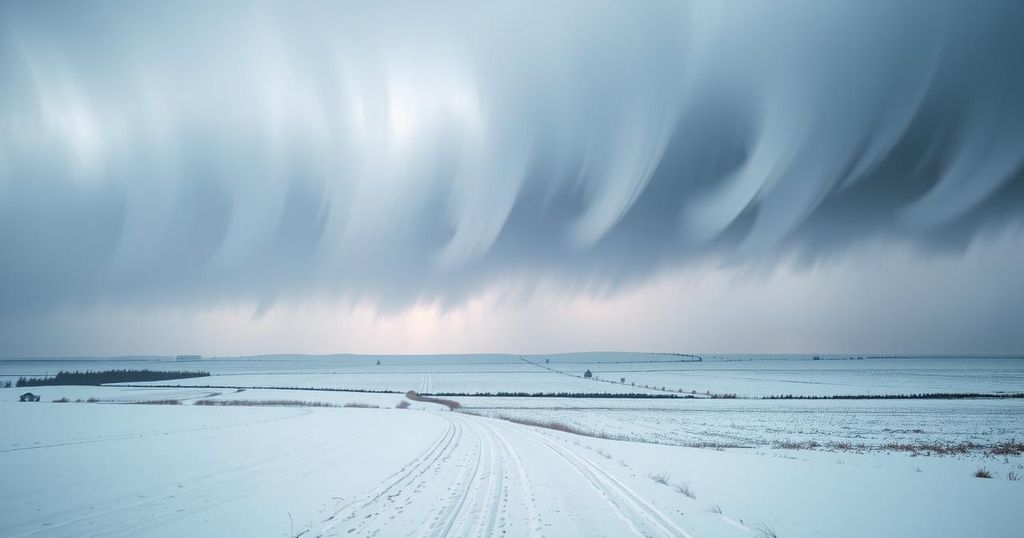Weather
76, ADIRONDACK, AFRICA, ATLANTIC, BRANDON BUCKINGHAM, BULGARIA, CANADA, CHICAGO, CLEVELAND, CLIMATE, DAKOTAS, DETROIT, EUROPE, FORECAST, GREAT LAKES, GREEN, GREEN AND WHITE MOUNTAINS, INDIANA, MARYLAND, METEOROLOGY, MICHIGAN, MID, MIDWEST, MONTANA, NEW ENGLAND, NORTH, NORTH AMERICA, NORTH CAROLINA, NORTHEAST, OHIO, OHIO VALLEY, PENNSYLVANIA, PLOWA, RAIN, SOUTH AFRICA, TENNESSEE, TENNESSEE VALLEY, THUNDERSTORMS, UNITED STATES, UPPER PENINSULA, VIRGINIA, WEATHER, WEST VIRGINIA, WHITE, WISCONSIN
Sofia Rodriguez
0 Comments
Severe Winter Storm Expected to Disrupt Travel Across Midwest and Northeast
A dangerous snow and ice storm is forecasted to affect the Midwest and Northeast from February 5-6, leading to hazardous travel and power outage risks. Major cities such as Chicago and Cleveland may experience significant ice accumulation, while thunderstorms could impact the southern flank, specifically in the Tennessee Valley. This storm is expected to be followed by another one over the weekend, continuing challenging weather conditions.
A severe snow and ice storm is developing across the Midwest and Northeast, resulting in hazardous travel conditions and a significant risk of power outages. This storm, anticipated from February 5-6, is expected to bring multiple types of precipitation, including snow, freezing rain, and sleet, impacting several states as it moves eastward. The storm is likely to create treacherous travel conditions across major roadways and airports, particularly from the Midwest to the mid-Atlantic and New England regions.
Accumulating snow is expected to cover areas in Montana and the Dakotas, advancing towards the Great Lakes and northern states. New England will experience snow as the storm progresses offshore, while rain and thunderstorms will affect the southern side from the Tennessee Valley to North Carolina, potentially leading to hail and intense wind gusts.
As the storm advances, cold air will interact with moisture, creating a corridor of sleet and freezing rain across the Midwest and Northeast. Major cities such as Chicago, Detroit, and Cleveland are at risk of experiencing significant ice glaze, which may disrupt morning commutes on busy interstate highways.
In New England, snowfall amounts will be limited to higher mountainous areas, though at least an inch may fall in the I-95 corridor. Monitoring will be essential in the New York City area as rain or snow depends upon overnight temperatures, potentially affecting Thursday’s morning commute.
Thunderstorms may develop across the Tennessee Valley, bringing hail as the primary risk. Nashville and Jackson, Tennessee, should remain alert as these storms progress northward. Following this storm, strong winds of up to 40 mph are expected in the Great Lakes region, affecting visibility on roadways.
As this storm concludes, meteorologists indicate that another storm may follow close behind, bringing additional snow, ice, and rain from the Central states to the East Coast over the weekend.
The article addresses a developing winter storm poised to affect travel across the Midwest and Northeast United States. With hazardous conditions expected due to various types of precipitation, individuals in these regions are advised to prepare for potential travel disruptions and power outages. The piece outlines specific impacts on major cities and highlights the overall risk posed by the storm.
In summary, a significant winter storm is set to impact the Midwest and Northeast from February 5-6, leading to hazardous travel conditions and potential power outages. Major metropolitan areas, especially in the Midwest, face risks from freezing rain and sleet, while southern regions may experience thunderstorms. Residents are urged to stay updated on changing weather conditions as additional storms may follow shortly after this event.
Original Source: www.accuweather.com




Post Comment